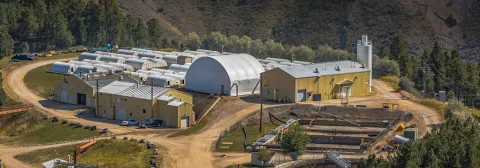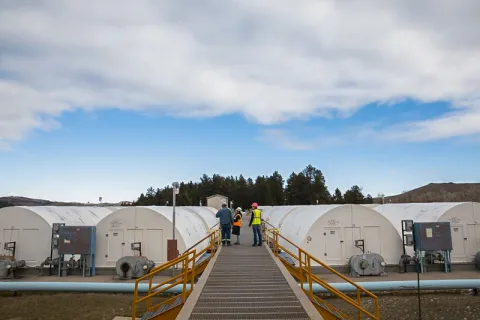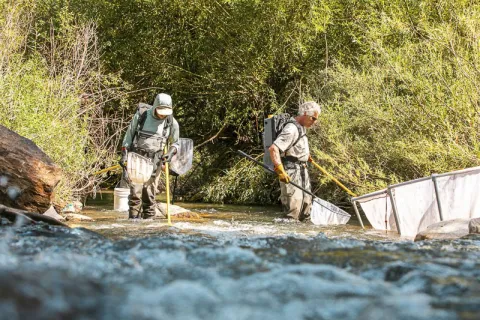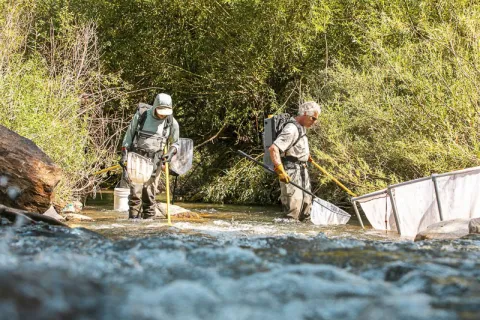Extremophiles that saved the waterways
Homestake became an industry leader in environmental cleanup and wastewater treatment
In the 1970s, while Ray Davis was underground taking data with the Solar Neutrino Experiment, another chemist was at work on the surface of Homestake Mining Company (Homestake). While Davis puzzled over the solar neutrino problem, chemist James Whitlock was working to clean up the waterways of the Black Hills. Although the transition of the facility to a full-fledged science laboratory was decades away, both researchers were forerunners in the fields of physics and biology, respectively, that would be studied there.
An industrial waste crisis
The Black Hills today are traced by clear-flowing creeks, dotted with lakes and awash with aquatic life. Just 50 years ago, however, the view from banks in the Black Hills was quite different.
Then, America was facing an industrial waste crisis. Industries, including mining, manufacturing and even agriculture, were leaking waste into waterways, contaminating the nation’s underground water sources.
In response, the Environmental Protection Agency was created in 1970, followed by the Clean Water Act in 1972, which introduced regulations that stymied the discharge of pollutants into the nation's surface waters, including lakes, rivers, streams, wetlands and coastal areas. Industries were facing new regulations and desperately searching for ways to clean their waste and remain in operation.
Many areas in Black Hills bore the mark of this environmental crisis. “I remember Whitewood Creek growing up, but I would’ve never called it a creek then,” said Whitlock, who grew up just 20 miles away in Spearfish.
That’s because, for most of the 20th century, Whitewood Creek flowed through the South Dakota towns of Lead and Deadwood, clogged with tailings and laced with toxic chemicals. The creek was grey, thick as sludge and known locally as “Cyanide Creek.”
Mining companies had long used cyanide to extract gold ore from crushed rock, releasing the tailings and chemicals into waterways. Whitewood Creek had become more than a local eyesore; full of pollutants, its path wound from the Northern Hills, pouring into the Cheyenne River, then the Missouri River and eventually the Mississippi River.
By the time Whitlock began working as a biochemist at Homestake, the mine was searching for a way to reverse industrial impacts to the area. In 1977, Homestake completed a tailings dam in Grizzly Gulch where heavy tailings could settle out of the water instead of clogging the creek. This, however, was mostly a superficial solution.
“The problem was, all of the cyanide and toxic metals were still flowing down the stream,” said Whitlock. “It looked cleaner, but from a toxicity standpoint, it wasn't. There wasn't any life.”
Homestake turned to its team of chemists, which included Whitlock; Carson Sharp, chief chemist; and Terry Mudder, environmental engineer.
“We tried chemical processes first,” said Whitlock. “But even if we were able to get rid of the cyanide with chemicals, the process itself created a leftover chemical soup that nothing could live in.”
A living, breathing solution
After a bleak meeting between Homestake officials and EPA lawyers, Whitlock sighed and turned to the EPA representative who sat next to him. “It’s too bad we never had time to try a biological option,” he said. The representative paused, yet said nothing. When the meeting reconvened, it was announced that Homestake had six months to find a biological option that would allow Homestake to continue operating.
“I honestly don’t think anyone thought a biological solution would work,” said Whitlock. “I think both sides were buying time. It was a bit of a fluke, really.”
Still, the team went to work, determined to use the allotted time to explore biological solutions.
"When I was in graduate school, we didn't have amino acid and DNA analyzers. One of the tests for identifying bacteria was that certain types could tolerate cyanide and some couldn't," said Whitlock. "I thought, well, if they can tolerate it, they have to have a mechanism that allows that."
The group discovered Whitewood Creek wasn’t completely lifeless. Certain extreme lifeforms were not only surviving in spite of the cyanide-laden water but had adapted to survive because of it. These extremophiles were using cyanide as an energy source.
By slowly introducing these bacteria to higher concentrations of cyanide, the team developed a strain that could breakdown Homestake’s cyanide waste. The bacterium was dubbed “Pseudomonas paucimobilis mudlock,” taking its last name from the scientists who developed it, Mudder and Whitlock.
Although multiple tests proved that the cyanide was removed, the next challenge was convincing others that the novel process of using living organisms to treat a poisonous chemical problem was legitimate—and worth the construction of a multimillion-dollar wastewater treatment plant.
Biological treatment was a novel idea at the time, especially to those outside the scientific community. Many officials within the EPA, and Homestake itself, were skeptical of this untried process. The team built a bioassay tank and filled it with biologically treated wastewater, then stocked it with trout, giving the skeptics visible proof of the microscopic change.
“We showed that not only did the trout survive, but actually, with the warm water, their growth rate was a lot faster and they were actually healthier,” said Whitlock.
Whitlock helped design the $10 million Waste Water Treatment Plant (WWTP) and the patented technology that would set nationwide trends, making Homestake an industry leader in wastewater treatment processes.

Present-day Waste Water Treatment Plant at Sanford Underground Research Facility. Photo by Matthew Kapust
Matthew Kapust
“In 1983, we got it in full-scale operation,” said Whitlock. “Within half a year, we did bioassessments on the stream—we started seeing organisms, fish coming upstream, and, within the first year or two, they caught a state record trout.”
In 1985, the same Time Magazine article that decried the water crisis in America, ended with a segment entitled “Turning to New Technologies” that showcased Homestake’s patented design for wastewater treatment.
How it works
The defining feature of the WWTP were dozens of Rotating Biological Contractors, or RBCs, that housed millions of thriving bacteria.

Present-day Waste Water Treatment Plant at Sanford Underground Research Facility. Photo by Matthew Kapust
Matthew Kapust
Once it was pumped from the underground or received from the cyanide breakdown process, the water flowed through the slowly rotating RBCs. The slow rotation of the cylinders allowed the bacteria to alternate between contact with the water below and much-needed oxygen above.
The first set of RBCs housed bacteria that broke down cyanide. “Cyanide is carbon and nitrogen, with a little triple bond between them. The bacteria didn’t actually eat the carbon or nitrogen. Instead, they are cutting that bond; that's where they get their energy,” explained Whitlock.
When the bond broke, carbon became CO2 and the nitrogen became ammonia, a toxic byproduct. The second set of RBCs housed bacteria that broke ammonia into nitrates, then further into nitrites, that could be discharged safely into the creek. The bacteria also absorbed suspended metals, including iron, silver, copper, lead and mercury.
“The beautiful thing about using bacteria,” Whitlock noted, “is that you don’t have to pay them. They do the work for food, and the food is the waste you’re trying to get rid of anyway.”
Over time, the bacteria even adapted to fluctuations in the wastewater, something that a chemical plant would be unable to cope with.
“There were a thousand different types of bacteria in there, everything that comes out of the mine or the tailings impoundment,” said Whitlock. “If you only had a single chemical to break down cyanide, you'd be dead in the water from a single spill. But living organisms can adapt. We got so we hardly ever saw an upset.”
Impacting future operations
The WWTP continued to operate until 2002, when the declining cost of gold forced Homestake to close. Whitlock worked with Homestake for 13 years before leaving to become a consultant for similar industries trying to reduce waste. He married Carson Sharp in 1986. They traveled to Russia, Africa, Canada, Mexico and South America as waste treatment consultants before eventually returning to Spearfish.

GEI Consultants, Inc. sampling Whitewood Creek's fish and macro invertebrate populations. Electrofishing (pictured above) allows consultants to temporary capture fish and monitor their weight, age and length.
Photo by Nick Hubbard
When the facility reopened in 2007 and began to transition into a science facility, Whitlock worked for Sanford Underground Research Facility (Sanford Lab) for seven years to help rehabilitate the WWTP. Because no gold is being processed, the treatment plant uses fewer RBCs, treating only suspended metals and trace amounts of ammonia in water pumped from the underground workings. Using the technologies perfected by Homestake, the plant is still a leader in environmental responsibility, continuing to monitor the health of nearby creeks, counting fish and macro invertebrate populations.
Epilogue
Today, the field that was marked by skepticism is now a leader in the industry. Biologists from around the world still come to the facility to study fascinating organisms, however, they focus on those that thrive underground. They gather samples from a number of levels and areas with different temperatures, chemical properties and geologic mineralogies.
In Sanford Lab's unique ecosystems, researchers have discovered extremophiles that have evolved to survive by consuming methane. Other microbes generate their own electricity with bioelectrochemical systems. Still others are being studied to understand how life could survive on other planets with similar stressors, like extreme heat, temperature, pressure, radiation and lack of sunlight.
Researchers hope that these life forms, like the bacteria discovered in the 1970s, will lead to industry and medical advances, as well as environmental restoration.

When the facility reopened in 2007 and began to transition into a science facility, Whitlock worked for Sanford Underground Research Facility (Sanford Lab) for seven years to help rehabilitate the WWTP. Because no gold is being processed, the treatment plant uses fewer RBCs, treating only suspended metals and trace amounts of ammonia in water pumped from the underground workings. Using the technologies perfected by Homestake, the plant is still a leader in environmental responsibility, continuing to monitor the health of nearby creeks, counting fish and macro invertebrate populations.
Epilogue
Today, the field that was marked by skepticism is now a leader in the industry. Biologists from around the world still come to the facility to study fascinating organisms, however, they focus on those that thrive underground. They gather samples from a number of levels and areas with different temperatures, chemical properties and geologic mineralogies.
In Sanford Lab's unique ecosystems, researchers have discovered extremophiles that have evolved to survive by consuming methane. Other microbes generate their own electricity with bioelectrochemical systems. Still others are being studied to understand how life could survive on other planets with similar stressors, like extreme heat, temperature, pressure, radiation and lack of sunlight.
Researchers hope that these life forms, like the bacteria discovered in the 1970s, will lead to industry and medical advances, as well as environmental restoration.
